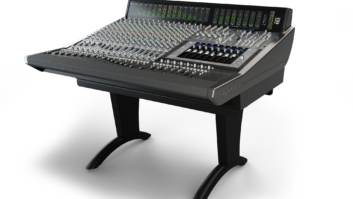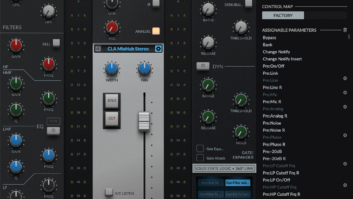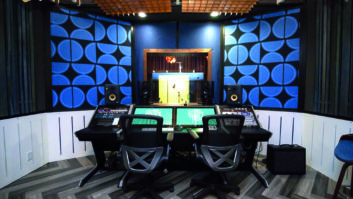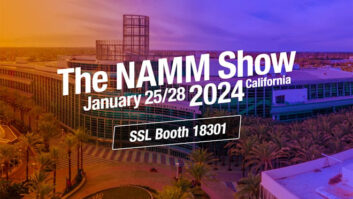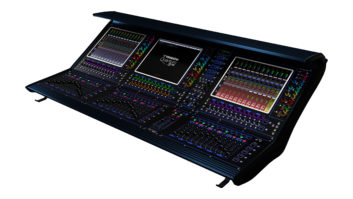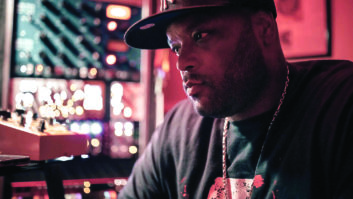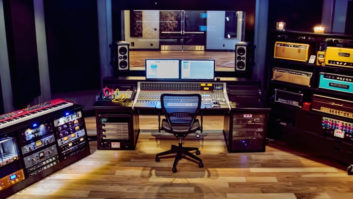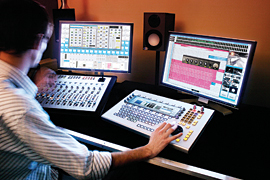
Because many pro studios use computer-based DAWs, operators are quickly seeing the benefits of total system control from their analog I/O devices. For greater workspace efficiency and workflow enhancement, hybrid console/controllers are proving to be increasingly popular. To address some obvious problems presented by separate hardware mixers and DAW control surfaces, ranging from size and price points to connectivity, many manufacturers now offer all-in-one solutions to meet professional needs.
WHY WOULDN’T YOU?
Hybrid console/controllers are becoming exponentially smaller and more efficient, and to an extent their feature sets are dictated by users’ analog demands. Units range in size from those that are solely geared toward desktop editing/recording to ones as long as bowling alleys for full-scale orchestral recordings.
According to Solid State Logic’s Dan Duffell, “SSL has been doing the hybrid controller/console thing for a long time — our entire console range features DAW control capability. Trying to describe how big one of our hybrid environments would be — if it were totally analog — is extremely difficult. Just imagine a 512-fader console with mic pre, instrument, line-level, various digital inputs, EQ and dynamics, control surfaces, joysticks for 5.1 panning on every channel and surround processing tools.”
These days, it’s feasible to remain exactly in the listening sweet spot — even when making edits across hundreds of virtual channels. This technology is epitomized by Smart AV’s Smart Console, which has been in production for four years now. “The key to this technology is in our optical touch sensor,” says Smart AV CTO/chairman Joseph Narai, referencing a custom-made meter bridge that arcs over the Smart Console. “It allows you to make a mix much more efficient. Firstly, you can access out-of-reach channels. So, for example, if I want channel 63, on a traditional long console I would do that by moving my chair across the unit. But in this case, my finger becomes my chair: I simply touch channel 63, and all of the channels appear around it on the control surface.”
Fairlight’s Xynergi takes a completely different approach. Its controller can be used as a desktop editor alone or as a 12-fader sidecar that’s integrated into a larger system capable of providing 230 channels, 192 tracks and 72 buses. The desktop unit can also jump from functioning as a Fairlight platform controller to a keyboard controller for Digidesign Pro Tools, Ableton Live or other DAWs.
All of these console/controller technologies are easy to use, save time and space, and reduce a console’s total number of controls by re-assigning them to cover many channels over virtual layers. While analog consoles have strong advantages in situations where an engineer requires or desires quick access to dedicated controls, they’re more costly than their digital equivalents because surfaces that have one-knob-per-job cost significantly more to manufacture.
PICK A PROTOCOL
Before looking at hybrid console/controllers designed for various segments of the media industry, one must first understand how they interface with digital audio workstations. Software and hardware must be able to “speak” to one another via protocols. One of the most common, basic protocols is HUI (Human User Interface), an open technology jointly developed by Digidesign and Mackie in 1996 and supported by many companies, including SSL and Tascam. HUI’s downside: It’s based on aging MIDI technology.
Some of the newer console/controller hybrids instead use patented, higher-grade protocols. Digidesign, for example, has abandoned its emulation of the Mackie HUI in favor of an Ethernet-based alternative. This “closed system” — a proprietary protocol capable of transmitting higher-resolution data — is exclusive to Digidesign. As an answer for those needing a more broad-based solution, Euphonix offers its EuCon cross-platform protocol.
Unlike Digidesign’s high-end console/controllers, all Euphonix EuCon products, including the S5 Fusion and System 5-MC, are compatible with Logic Pro, Nuendo, SONAR, Final Cut Pro, Vegas Pro, Digital Performer and Pyramix, as well as Pro Tools. Euphonix sales executive Luke Smith expands: “EuCon allows its partner-manufacturers the full bandwidth they need to fully integrate their software into our control surfaces. In addition, EuCon’s universal appeal proves it to be a powerful tool for so many different users, regardless of their preferred DAW.”
WHAT DO YOU NEED?
Selecting a hybrid console/controller will depend upon the type of work you do and what software you use, as well as the level of control you need. In trying to establish the factors to consider when buying one, we spoke to some high-end users.
“We have a Digidesign D-Command ICON system,” says Alex Harris from the Gateway School of Recording in London. “But we still use a TL Audio 24-channel valve [tube] mixer as the front end because it gives a warmer, fuller sound. We are also looking at getting an SSL AWS 900+ hybrid console/controller, which has quality onboard preamps.”
Harris is obviously looking to find the best balance between analog and digital. “By offering a tactile control surface, all of these systems save a huge amount of time and effort — and money — in terms of mixing,” he says, “enabling the user to more comfortably interact with the sounds they are manipulating. We are, after all, analog creatures, with two hands and 10 digits. We work better with multiple, continuous controllers rather than just one nasty little mouse.”
London’s Wave Recording Studios is an all-digital audio post facility, working with major accounts such as Sony, Microsoft, Levi’s, Guinness and Audi. I talked to sound designer Joe Mount about his experience with the new breed of studio tools. “As far as film production goes, it’s probably a case of speed,” Mount explains. “You can move mixes around and reference old ones as quickly as possible. These new mixers — where everything is accessible out-of-the-box — appeal to Wave because they have added functionality and enable us to do what we’ve always wanted to with analog desks. Moving automation down a timeline on a soundtrack isn’t half as easy as doing it on clips in your DAW.”
Sitting on Mount’s desk is a Fairlight Xynergi and a Euphonix MC5. “The Xynergi is very, very different to the MC5, and in turn the ICON is alien to the MC5, but essentially they are all doing the same thing,” he adds. So in the face of Ethernet protocols, does Mount think MIDI-based ones like HUI may become redundant? “It’s hard to say and depends on whether all the big players are making their own controllers,” he replies. “The MC5 uses EuCon. It works nicely with the MC5, and its Nuendo functionality is seamless and superb. The protocol it uses is actually owned by its manufacturer, as opposed to a third party, which is nice to know when looking to buy an MC5.”
Does Mount find it frustrating that companies such as Digidesign restrict their top controllers — like ICON — for use only with their own software? “It’s not frustrating, but it’s definitely something that factors in when making a decision whether to invest in the technology. If we were to switch systems, we wouldn’t be able to use that controller anymore, as opposed to the MC5. Having said that, if EuCon doesn’t catch on, Digidesign will still be making the same reputable hardware.”
I ask Tim Vine-Lott, technical manager of AIR Studios — founded by Sir George Martin — for his opinion on the debate. “The Holy Grail is to have all your analog and digital needs catered for in a wholly integrated system,” he says. “It may not need to be one single unit. There are a few manufacturers aiming to make that a reality. I think Euphonix is pretty much top of the field at the moment. Meanwhile, Digidesign has gone a new way through ICON and D-Control via a protocol they don’t release to the outside world. At the top end of the scale there are a number of users who don’t think that’s a particularly useful way of going about things. ICON and D-Command are not the best control surfaces in the world. You cannot, for example, record a film score with an 80-plus-piece orchestra on an assignable, layered digital surface. You need to be able to see every single thing, which is why we have a [Neve] 88R.”
AIR Studios has a Neve DFC in Studio 3, which, according to Vine-Lott, is arguably the best film mixer available, providing a level of DAW control. “In a mix environment,” Vine-Lott explains, “we’re getting away from multiple users. Traditionally, for film mixing in dubbing theaters, you still do have music, dialog, effects and overall mixdowns handled by separate personnel. That’s being shrunk down now, so you’ll have one engineer that does music, dialog and effects and then bounces the whole thing up. That user wants something small, where everything’s in reach from one seat, and this is where a small, assignable console comes into its own. But that’s only at the mix stage. When recording on a large analog console, engineers know where everything is, so if something’s wrong, they know exactly where to look. But if someone has to dive down three layers and four pages to get to a problem, they’ll literally going to throw it out of the door, and that will be the end.”
DECISIONS, DECISIONS
From what’s been said, it’s quite clear that there are some solid choices for studios looking to buy a hybrid console/controller — although it may not be the be-all, end-all. For instance, film scoring, recording studios and editing studios require different hardware solutions in terms of size, I/O, compatibility and configuration.
On page 34, we’ve compiled a list of hybrids that offer line or mic inputs, have a monitor section for speaker control/volume and the ability to control DAWs from their surfaces. To keep things focused, we did not include controller-only systems having no audio I/O capability, so products such as SSL’s Matrix, Mackie’s Control Universal Pro and the Euphonix MC Mix/MC Control are not included.
No matter what solution you’re seeking, keep in mind that hybrid hardware is still in its infancy. New models are coming out at a feverish pace, and it should be relatively easy to find something that suits your needs.
John Murray Hill is a London-based journalist, DJ and electronic music producer.
